| Article ID | Journal | Published Year | Pages | File Type |
|---|---|---|---|---|
| 8919775 | Veterinary Anaesthesia and Analgesia | 2017 | 16 Pages |
Abstract
Impala are an important species of antelope in Africa and are often captured during management procedures, veterinary interventions and research projects. Chemical capture is a preferred technique over physical capture and restraint for veterinary interventions as it allows for easier handling and better clinical assessment and treatment. However, this capture technique results in high mortality (4%) and morbidity rates (23%), which translates into animal welfare and economic concerns. Investigation of environmental, drug and drug delivery, and animal factors to elucidate the origin of these high rates was reviewed. The greatest risks emanate from the drug and drug delivery factors where potent opioids (etorphine and thiafentanil) cause profound respiratory compromise, that if left untreated often translates into fatalities. Furthermore, the procedure of darting, an essential tool in game capture, can cause irreparable fractures and other fatal injuries mainly through accidental misplacement of the dart into a long bone, thoracic or peritoneal cavity. Impala are anxious and flighty, and this demeanour (animal related factor) can contribute towards mortality and morbidity rates. Impala that mount an inappropriate stress response to capture tend to die; therefore, procedures that induce an intense stress response (awake clinical examinations) should be avoided. Sequela of a heightened stress response include capture-induced hyperthermia, myopathies, fractures, maladaptation to confinement or new environments and death. Impala serve as a useful model for improving immobilizing and anaesthetic drug protocols, darting techniques or new methods of remote injection in wildlife. However, the risks associated with chemical capture in this species should be understood, and all efforts to mitigate these should be employed.
Related Topics
Life Sciences
Agricultural and Biological Sciences
Animal Science and Zoology
Authors
Gareth E. Zeiler, Leith C.R. Meyer,
